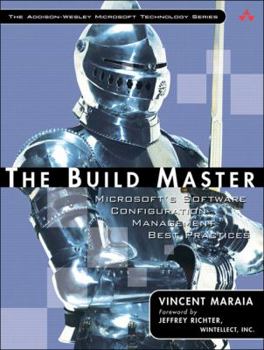The Build Master: Microsoft's Software Configuration Management Best Practices
Stephen Zeff has been a prolific researcher on the history of accounting and auditing in the twentieth century. He has written numerous papers on the history of standard setting and regulation, of... This description may be from another edition of this product.
Format:Paperback
Language:English
ISBN:0321332059
ISBN13:9780321332059
Release Date:September 2005
Publisher:Addison-Wesley Professional
Length:249 Pages
Weight:1.25 lbs.
Dimensions:0.8" x 7.1" x 9.2"
Customer Reviews
5 ratings
Several Microsoft ways that work and you can learn from
Published by Thriftbooks.com User , 16 years ago
While many people bash Microsoft for what they consider the dubious quality of their software products, there is no question that they must have an efficient configuration management system. With so many designers, developers and testers working on any single product, it would be very easy for any software development project to descend into chaos. Since Microsoft does manage to push new products out the door on a regular basis, they have to do a great deal right in the area of configuration management. This book describes the Microsoft experience and strategies they use in managing their product build, testing, customer support and service pack cycles. There is also a chapter on some ways to change the corporate culture and the final chapter describes future build tools that will be released by Microsoft. A great deal of the Microsoft experience is certainly expected, believable and worthy of emulating. Whatever the size of your development teams, the best way to learn efficient and effective ways of configuration management is to study what the biggest teams do. If they can do it efficiently then by copying them, you can get that same efficiency and perhaps squeeze it a little tighter due to your reduced size.
Great Book! Something for Everyone!
Published by Thriftbooks.com User , 18 years ago
I have been in the computer industry for over 30 years and found this book to be very interesting and informative! Vincent does a great job of defining a build and explains how computers work(all one's and zero's), what compilers(inherently dumb)do, and general computer info like debug symbols, international binaries, build verification tests, and everything else you need to know about shipping a product. I really liked his 'tongue-in-cheek' approach and all of the 'war stories'. There are some things he could have left out like the section on e-mail rules but overall I found every chapter valuable to me and my organization. This book has now become mandatory reading for our company. The book did leave me wanting a little more detail and information on some topics such as tools, but maybe Vincent will write a sequel with details on specific tools. Or I can go to the specific tool site and get details from them. Overall I highly recommend this book to anyone wanting to learn about processes used at Microsoft that have been successful over the years. Bob
a centralised build process
Published by Thriftbooks.com User , 19 years ago
If you have a team of 30 or more programmers, then Maraia offers good suggestions on how to design your build processes so that these can both handle your current team, and scale up to hundreds or even thousands of programmers. The book uses Microsoft's own development effort as the central case study. Given that Microsoft has massive software development efforts, you may want to pay attention. The book can be read at two levels. One is if you want to use the development tools from Microsoft, that the book talks about. If your team works under a Microsoft operating system, and uses Visual Studio, then indeed, this can be germane. But you don't have to be using any Microsoft product at all, to reap some gain from the text. The key idea is to have a group of developers who maintain a centralised build process. (They can certainly have other duties.) Here, the book argues about having a metalevel, if you will. Where this build process can and will change over the project's lifetime. If the project has several subgroups, as it will if it is large enough, then each subgroup uses this same central build to make its own binaries. The centralising fights a natural tendency for a large project to have subgroups that drift apart. In part by imposing a top-down discipline on the subgroups to have their developments conform to this build. The book also goes into various good practices that your group should use. These have been covered in other books on software projects. The distinctive part of the text is the above discussion on the centralised build.
You too can be a Build Master
Published by Thriftbooks.com User , 19 years ago
This book is a great look into Software Configuration Management from someone who's been in the trenches. If you are new or experienced with SCM, this book will provide you with new information.
Did you like Bob the Builder? If so, you'll love this one!
Published by Thriftbooks.com User , 19 years ago
What can I say? I review a big part of the book as someone with very little experience in that topic and I was able to understand it! I don't think there are that many books taking that approach when talking about the building step so, thank you Vince!





